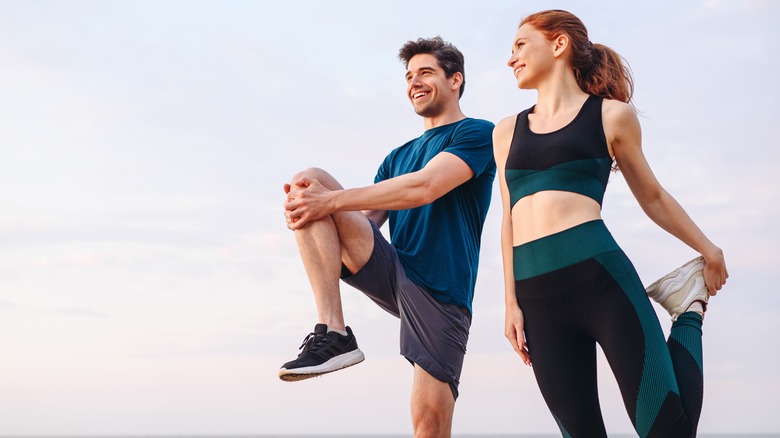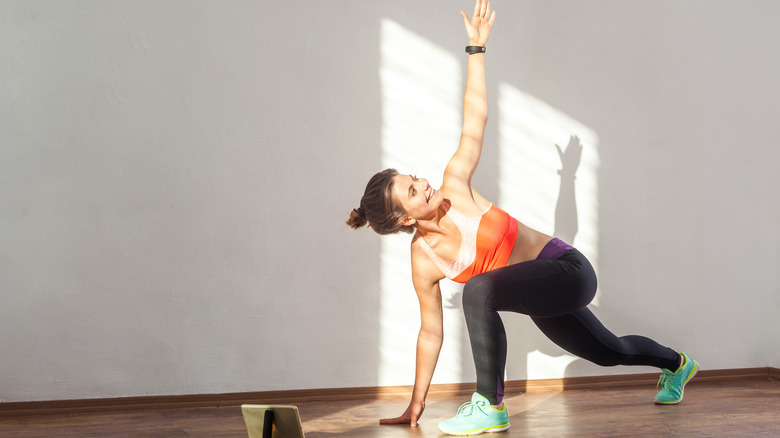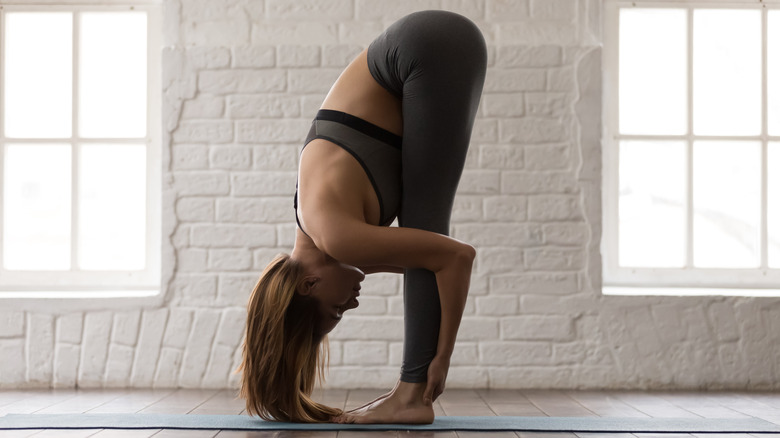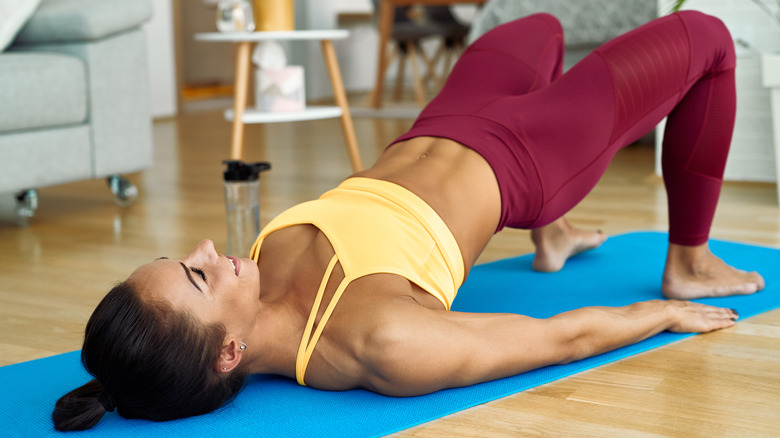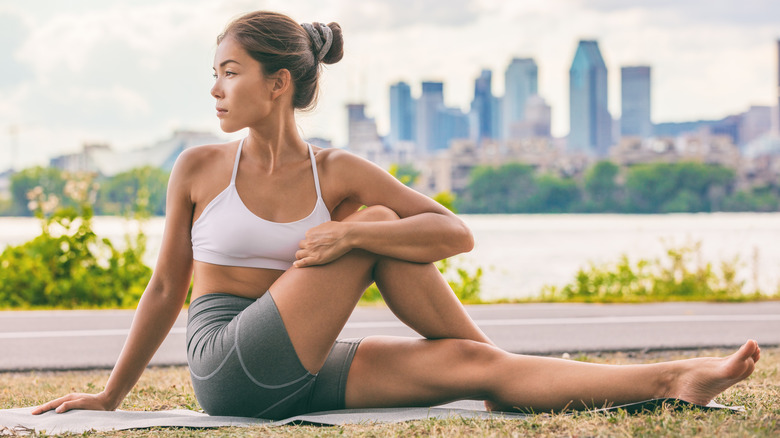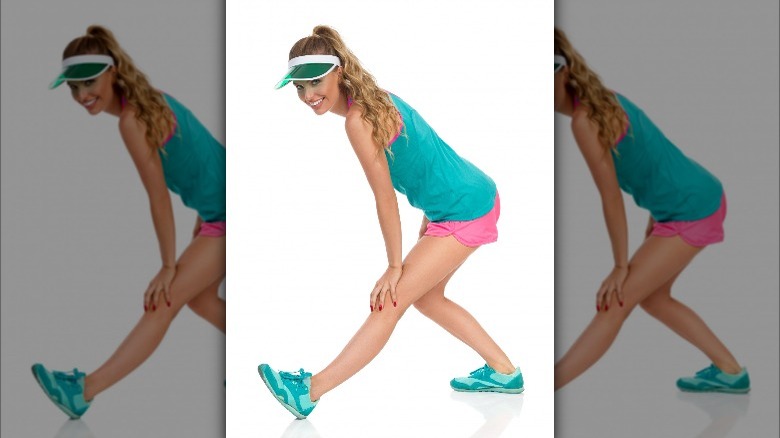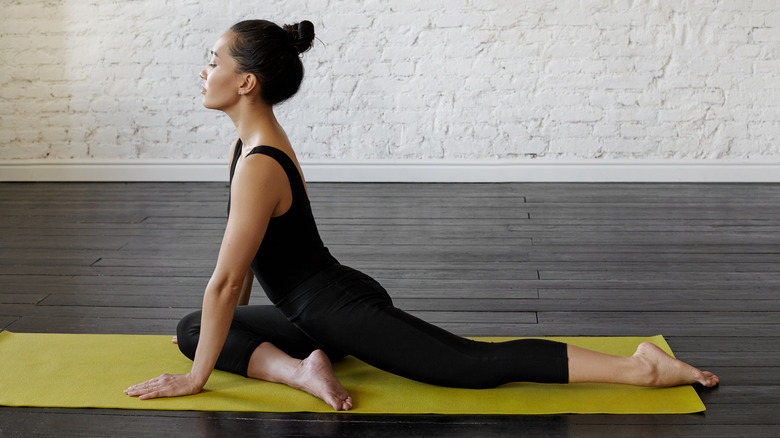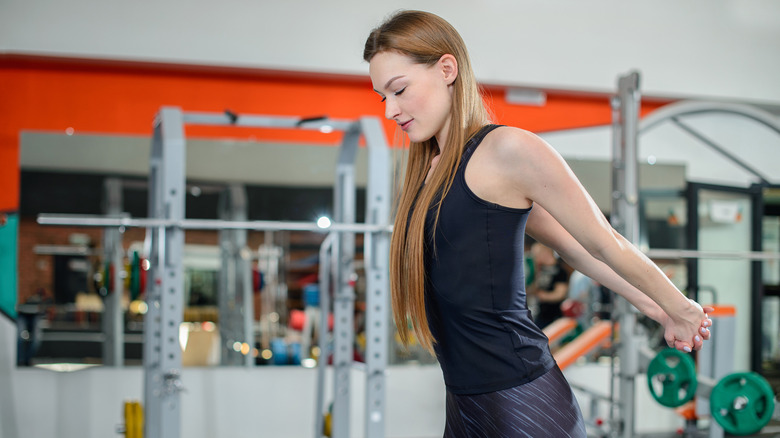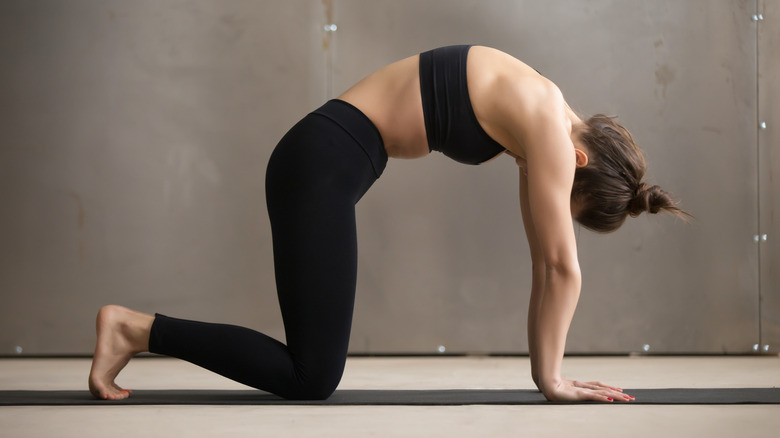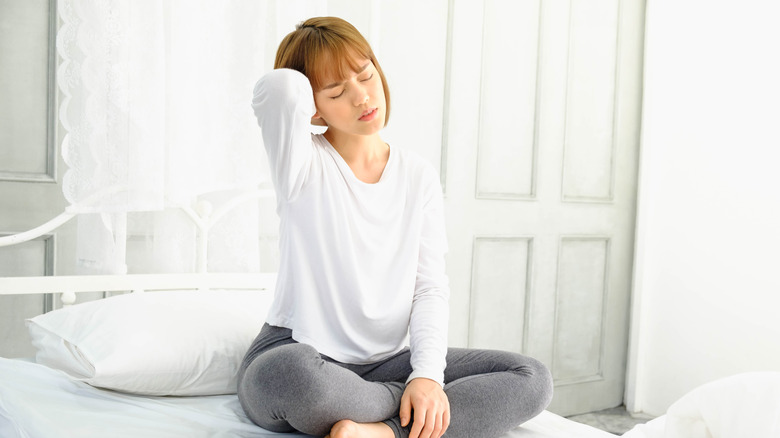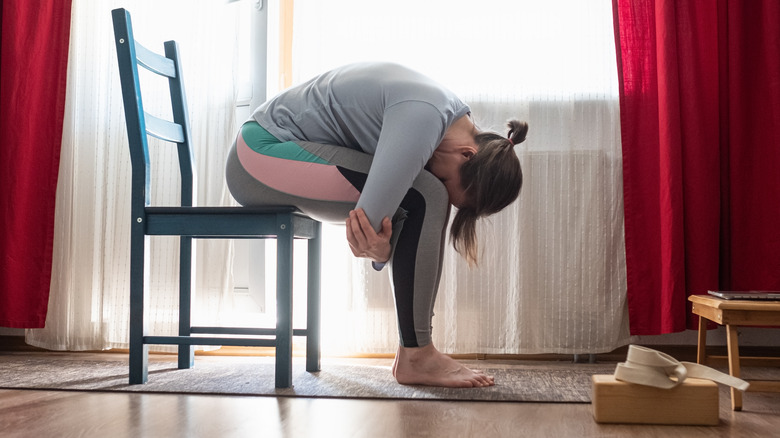The Best Stretches To Stay Flexible During Your WFH Day
Working from home comes with many privileges, from spending precious time with pets to never having to wear pants without an elastic waistband. However, it also contributes to a dramatic decrease in regular physical activity. According to CNBC Make It, the average person working from home is missing out on basic activity acquired from daily commutes and office life, thereby experiencing an increase in musculoskeletal pain in the back, neck, and shoulders. Creative at-home desk solutions like couches and kitchen tables also negatively impact people's bodies, as these furniture pieces lack the right kind of support for long periods of sitting (via Ergonomics Help).
The solution is simple: move more. Regular exercise, including brisk daily walks, is vital for reducing overall pain resulting from working from home (via the National Library of Medicine). Stretching throughout the workday is also incredibly beneficial for managing aches and pains and increasing flexibility. Mayo Clinic explains that stretching helps improve the range of motion in joints, increases muscle blood flow, and helps muscles work their best. Five to ten minutes of stretching at least three times per week are all that is needed for a noticeable improvement in body pain.
The best WFH stretches are simple movements that don't require any equipment. Some can even be done from your desk chair. Read on for a breakdown of the best stretches to stay flexible during your work-from-home day.
World's greatest stretch
If you make time in your day to do one stretch, make it the "World's Greatest Stretch." The move is a combination of two simple but effective full-body stretches that open the hips, mobilize the spine, and help wake up some of the body's largest lower leg muscles. According to Today, this dynamic mobility movement is a phenomenal way to loosen the body after a long day of sitting and typing.
YouTube channel Squat University instructs newcomers to the stretch to start in a deep lunge position with the back leg straight and the front knee in line with the ankle. Drive your back heel towards the back of the room to wake up the hamstrings. Once in a stable lunge, squeeze your glutes to feel the stretch in the hips and pull the belly button in towards the spine to stabilize the core muscles. Then, gently twist your torso towards your bent leg, reaching your arm up towards the ceiling. If you are new to stretching and find yourself lacking the strength or flexibility to perform a standard lunge with a twist, consider bending your back leg and having it touch the floor. This will improve your stability and allow you to focus on a mindful torso twist.
When performing the world's greatest stretch, it is important to move through the movements slowly to avoid injury. Don't let your bent knee extend past the toes, and make sure not to overextend during the twist.
Standing forward fold
In yoga, the forward fold pose, also known as uttanasana, is a foundational pose used to stretch the back muscles, lengthen the spinal column, and stretch the hamstrings and backs of the legs. It is also helpful for stimulating the nervous and endocrine systems, aiding digestion, and helping relieve headaches (via Yoga Basics).
To perform a forward fold, stand with your feet together and spread your weight evenly between both feet. Make sure to stand up tall and keep a soft bend in the knees as you hinge forward at the hips. Melt the belly into the tops of the thighs and release the crown of the head towards the floor, making sure your hips and sit bones are pointed up towards the sky. Release the arms and let your palms touch the floor, focusing on allowing the body's full weight to sink towards the earth. Breathe in and out for four to eight breaths before coming back up to a standing posture.
Despite the stretch's simplicity, it requires a certain degree of mindfulness. On her popular YouTube channel, Yoga with Adriene, yoga teacher Adriene Mishler says, "... you can't just dive into the forward fold and expect the magic to happen. You have to be with the breath, you have to look at what's really going on in the backs of the legs, and then, of course, find what feels good."
Glute bridge
If you suffer from chronic low back pain as a result of working from home, incorporating a static glute bridge into your stretching routine can help. According to Healthline, this versatile, effective exercise targets the entire posterior chain, including the glutes and hamstrings. Sitting at a desk or curling up on the couch all day is a surefire way to cause these muscles to tighten and weaken. When weak, these muscles contribute to an unstable core and an achy lower back. Activating them will not only improve back and core strength, but can improve hip flexibility and improve posture over time.
There are a number of variations to this exercise, but the standard glute bridge is effective on its own. Start by lying on the floor with your feet flat on the ground and your knees bent towards the ceiling (via Coach). Extend your arms out on either side of your body. Pull your belly button in towards your spine to stabilize the core. Then, lift your hips off the ground, forming a straight line with your hips, knees, and shoulders. Squeeze your glutes at the top of the movement, holding the pose for two to three seconds before slowly lowering back to the floor. For best results, perform three sets of up to 15 reps several times per week.
Seated spinal twist
The seated spinal twist is an energizing stretch that targets the major muscles of the back and hips. It also stretches out the chest, obliques, abdominals, and glutes. Seated spinal twists are used often in yoga to help cleanse the digestive tract, elongate the spine, and improve posture.
To perform a seated spinal twist, sit on the floor with your legs straight out in front of you (via Mayo Clinic). Ground down through the sit bones and focus on sitting up straight. Then, place your hands behind your back with your fingers facing outward. Take your right foot and place it on the outside of your left knee, leaving your knee bent. Gently place your left elbow on the outside of your right knee as you inhale and on the exhale twist your torso to the left. Repeat on both sides, holding the stretch for five full breaths.
You can also perform this stretch in a chair (via Yoga Journal). Sit on the edge of your seat with your feet planted firmly on the ground. Your feet should be parallel to one another, with your legs bent at 90-degree angles. Place your right hand on the outside of your left knee, and place your left hand on the back of the chair. Turn your body into the twist, repeating on both sides. No matter what variation you choose, it is important not to overextend your torso into the twist or wrench your body into the stretch.
Standing hamstring stretch
The hamstrings, or muscles that run down the back of your legs, are incredibly important muscles for general mobility. According to Medical News Today, many people experience tight hamstrings after long periods of inactivity, such as sitting at a desk. The good news is, loosening up the hamstrings is easy with the right stretches. Many of these beneficial stretches can be performed sitting or standing, but standing is going to provide a deeper stretch.
The standing hamstring stretch is a great way to target the hamstrings in your stretching routine. To best perform this stretch, you will need to stand near a step or similar elevated surface. Keeping your spine straight, extend your leg out in front of you. Place your heel on the step with your toes flexed and pointed toward the ceiling. Hinge forward at the hips until you feel a nice stretch in the back of the leg and hold for 15 to 30 seconds (via Verywell Fit). If you don't have access to a step, place your foot in front of you and lean into the stretch as normal, keeping your hands on the upper thigh of the stretching leg for balance. For best results, repeat the stretch three times on each leg twice per day.
Pigeon pose
The Pigeon Pose is an intermediate yoga pose that is incredible for the lower body. According to Greatist, this stretch is ideal for opening up the hip flexors, the lower back, and the groin. It also targets the gluteus medius and minimus, also known as the parts of the butt that make up the hip rotator muscles. Pigeon Pose and its advanced variations can be a bit intense if you aren't used to the movement or have really tight hips from sitting all day. Take care to warm up with a few minutes of light cardio before tackling the stretch and go slowly through each movement.
Pigeon Pose is a combination of a half split and an externally rotated knee, per The Yoga Nomads. Start off in a tabletop position with your hands beneath your shoulders, your knees beneath your hips, and a neutral spine. On an inhale, bring your right bent knee forward, sliding your foot under the left side of the body at the hip. Engage your left thigh to straighten your back leg. You should feel a deep stretch on the outside of the right hip and into the gluteal muscles. Repeat on both legs.
Once you feel comfortable with the basic elements of Pigeon Pose, you can increase the stretch by adding in a forward fold. Make sure to keep your hips square and your right knee directly under your right armpit. Your weight should also be evenly distributed throughout the legs and hips.
Double-arm chest stretch with arms behind back
Desk jobs are notorious for creating tight chest muscles, causing slumped shoulders, crunched necks, and abysmal posture. When tight, the chest muscles shorten and weaken, leading to general pain and discomfort that make everyday activities difficult to accomplish (via The Healthy). They can even affect the mobility of your spine and lead to numbness or tingling in the shoulders, arms, and hands. Incorporating a standing chest and shoulder opener into your stretching routine is a great way to help loosen up these tight, shortened muscles and maintain a healthy body.
A double-arm chest stretch with the arms behind the back is a basic but effective movement. Start in a standing position with your spine straight and your legs shoulder-width apart (via A Lean Life). Reach both arms behind you with your palms facing together. Interlock your fingers. Then, gently push your arms up and back until you feel a stretch in the chest and shoulders. Hold the stretch for 10 to 30 seconds and then release, bringing your arms slowly back to your sides.
Cat-cow
Cat-cow is a beloved yoga movement that combines the Marjaryasana, or Cat Pose, with Bitilasana, or Cow Pose (via CNY Healing Arts). This gentle, breath-synchronized stretch is excellent for increasing spine mobility, releasing tension in the upper and lower back, stretching the chest, and improving posture. It also aids with balance, stretches the hips and core, and provides a nice massage of the kidneys and adrenal glands (via Everyday Yoga).
Start on all fours in a tabletop position, maintaining a neutral spine and awareness in the neck. On an inhale, drop your belly toward the floor and lift your head towards the ceiling, putting a gentle arch in the spine. Focus on drawing your shoulders down away from your ears. On an exhale, slowly draw your belly back into your spine and round your back, bringing your head down in a forward fold. As you inhale again, move back into Cat Pose. Repeat for 10 to 20 breath cycles.
Combining the two beginner-friendly stretches into one cohesive movement is a great way to warm up the spine before strenuous exercise. It is also a good way to wake up the body when you get out of bed in the morning.
Levator scapula stretch
According to Spine-Health, regularly stretching the supportive muscles, tendons, and ligaments surrounding the spine is important for alleviating back and neck pain. Additionally, stretching these parts of the body at home can help improve your range of motion, increase mobility, and prevent the risk of injury or disability as you age.
Muscle strain in the neck and back is a common side effect of desk jobs and low physical activity. Stretching the levator scapula, or the long muscle that runs down either side of the neck and into the shoulders is important for reversing that pain. This stretch can be performed seated or standing with the help of a wall or door jamb.
If seated, start by sitting on the edge of your chair with a straight spine. Bring your right arm up and reach it back, grabbing onto the right shoulder blade. Apply gentle downward pressure to the shoulder blade. Then, rotate the head 45 degrees to the left and tilt the chin down toward your chest. You should feel a deep stretch on the back right side of your neck. To modify this stretch, keep your arms in front of you. Grab your right arm and gently pull it across your body before tilting your head down and rotating the body away from the right side of the body (via Summit Orthopedics).
Seated lumbar flexion stretch
You can easily reduce the stress on the lumbar region of the spine by performing flexion exercises or stretches. When done properly, these stretches enhance lumbar flexion and strengthen the glutes and core muscles to relieve persistent low back pain (via Physiotherapy-Treatment.com). Lumbar flexion stretches are also good for opening the hip flexors and intravertebral foramina. They are commonly used to treat medical conditions such as Spinal Stenosis and Spondylolisthesis.
The seated lumbar flexion stretch is simple. Sit in your office chair with your spine straight and your shoulders pulled away from your ears. Plant your feet firmly on the floor, keeping them parallel to one another. Bend forward and place your arms behind the knees, grasping the opposite elbow. Drop the head with your face resting comfortably between your knees. To come out of the stretch, release the elbows and slowly come back into a seated position (via Physical Therapy First).
Go for a walk
Although not a stretch you can do from the comfort of your home office or living room, going for a walk is an important exercise that can help alleviate aches and pains from sitting too long.
The benefits of walking are numerous. In addition to strengthening bone mass, improving sleep, and releasing mood-boosting endorphins into the body, walking can strengthen leg and abdominal muscles which leads to less back and hip pain. The Arthritis Foundation explains that walking 30 minutes per day can lower a woman's risk of stroke by 20% while walking one to two miles per day can significantly decrease blood pressure. It can also support healthy joints by lubricating the cartilage, something that can only happen through dynamic movements like walking (via NPR). Plan to take a walk on your lunch break a couple of times per week, with the goal of stretching afterward.
Making time in your workday to walk around every hour is a great way to combat the sedentary lifestyle associated with working from home. Penn Medicine recommends setting a timer every 60 minutes to remind you to get up and move around, even if it is only for a couple of minutes. They also recommend sneaking in walking while your work via a treadmill desk or walking while talking on the phone.
